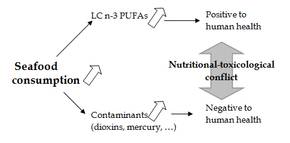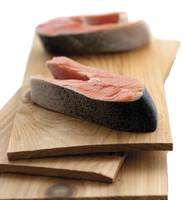|
|
|
The nutritional-toxicological conflict related to seafood consumption was studied in detail in order to formulate clear recommendations to the Belgian population. Different probabilistic intake assessments using data from the Belgian SEAFOODplus consumer survey in 2004 were performed. The consumer survey was part of projects Project 2.3 SEA-INFOCOM and Project 2.1 CONSUMERSURVEY. The research described in the present SAN summarises the work published in three different papers and in the PhD thesis of Dr. Isabelle Sioen from Ghent University in Belgium. The conclusion is a positive message for seafood consumption: the health benefits from eating fish twice a week clearly outweigh eventual safety risks.
Authors: Isabelle Sioen, Wim Verbeke, Stefaan De Henauw, John Van Camp, Ghent University, Belgium.
Seafood represents a natural source of valuable nutrients (e.g., long chain omega-3 polyunsaturated fatty acids (LC n-3 PUFAs), vitamin D, and iodine), but the favourable health perception is troubled by the presence of contaminants such as PCBs, dioxin-like compounds, (methyl) mercury (MeHg), and flame retardants. This dualism forms the basis for a potential nutritional-toxicological conflict.
 - Figure 1. Nutritional-toxicological conflict related to increased seafood consumption
Due to this nutritional-toxicological conflict, it was of interest to evaluate the risks and benefits related to the consumption of seafood in order to formulate safe recommendations about seafood consumption for the Belgian population. A methodology and a software module were developed for executing probabilistic assessments of the simultaneous intake of multiple compounds leading to better insights in the problematic nature of food items involving both health benefits and safety risks. For the intake assessment, nutrient and contaminant data of seafood species available on the Belgian consumer market were used. These data resulted from different studies and monitoring programs.
In the first study, the intake of LC n-3 PUFAs, vitamin D, iodine, PCBs, dioxin-like compounds and mercury was studied on the basis of the current seafood consumption pattern of the Belgian population. The simulations predicted that, as far as only seafood consumption is concerned, Belgian adults do not reach a sufficiently high intake for the three nutrients considered (LC n-3 PUFAs, vitamin D, and iodine). Regarding the contaminants, (methyl) mercury contamination of seafood on the Belgian market does not emerge as an issue of major toxicological concern. In contrast, for dioxin-like compounds the tolerable daily intake is reached by people with a high seafood consumption (i.e. several times per week a portion of fatty fish).

In the second study, the probabilistic model was used to calculate the simultaneous nutrient and contaminant intake for different fish consumption scenarios in order to formulate consumption advice. The results indicated that the Belgian recommendation for LC n-3 PUFAs can be reached by consuming fatty fish a minimum of twice a week, or by varying between lean and fatty fish a minimum of three times a week. At this fish consumption level, methyl mercury intake is not an issue of toxicological concern. The intake of dioxin-like compounds approximates the tolerable weekly intake when consuming fatty fish more than twice a week, this being a potential toxicological risk because other food items also contribute significantly to the intake of dioxin-like compounds. On the basis of these conclusions, clear dietary advice about fish consumption can be given to the Belgian population, in order to increase their LC n-3 PUFA intake without raising major toxicological concerns.
The last study focused on another group of contaminants, i.e. polybrominated diphenyl ethers (PBDEs). These chemicals are used as flame retardants in large number of consumer products. A probabilistic intake assessment of PBDEs and healthy LC n-3 PUFAs was conducted for Belgian fish consumers in order to study the balance of the intake of LC n-3 PUFAs and PBDEs. Based on the observed fish consumption level in the SEAFOODplus sample, the mean intake of PBDEs via fish was 0.85 ng/kg body weight (bw)/day. The intake of LC n-3 PUFAs was 3.45 mg/kg bw/day, which is low compared to the recommendations. Scenario analyses showed that consuming 150 g salmon twice a week is advisable to achieve the recommended LC n-3 PUFA intake with a rather low PBDE intake. When replacing 150 g salmon by herring, the PBDE intake is higher without an increase in LC n-3 PUFAs. In contrast, the combination of cod and salmon leads to a similar PBDE intake compared to twice a week salmon, but to a lower LC n-3 PUFA intake.
In conclusion, the studies support that the benefits of consuming fish two or three times a week outweigh the eventual safety risks. However, the conclusion that seafood consumption twice a week would not lead to contaminant intakes of major toxicological concern is essentially conditional upon compliance of existing structural and rather strict rules and regulations, and that extensive control programs aiming to prevent that highly contaminated food items (above the EU limits) become available for consumers. In other words, the positive conclusion from this study should in no way be interpreted as an argument in favour of any weakening or downplaying of current regulations and monitoring programmes.
References:
Sioen I, Van Camp J, Verdonck F, Verbeke W, Vanhonacker F, Willems J et al. Probabilistic intake assessment of multiple compounds as a tool to quantify the nutritional-toxicological conflict related to seafood consumption. Chemosphere 2008; 71(6):1056-1066.
Sioen I, De Henauw S, Verbeke W, Verdonck F, Willems JL, Van Camp J. Fish consumption is a safe solution to increase the intake of long chain n-3 fatty acids. Public Health Nutrition 2008; In Press. doi: 10.1017/S1368980007001450.
Sioen I, Bilau M, Verdonck F, Verbeke W, Willems JL, De Henauw S et al. Probabilistic intake assessment of polybrominated diphenyl ethers and omega-3 fatty acids through fish consumption. Molecular Nutrition and Food Research 2008; 52(2):250-257.
Sioen I. The Nutritional-Toxicological Conflict related to Seafood Consumption. PhD-thesis. Ghent, Department of Public Health, 2007, 233 p. ISBN 978 90 7834 407 0.
The thesis of Isabelle Sioen can be ordered as a pdf file from the author ( isabelle.sioen(at)ugent.be). For future referencing and citation, readers are asked to refer primarily to the original journal papers. isabelle.sioen(at)ugent.be). For future referencing and citation, readers are asked to refer primarily to the original journal papers.
|
|
|
|